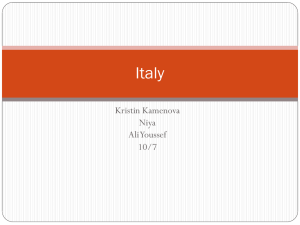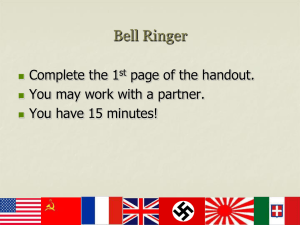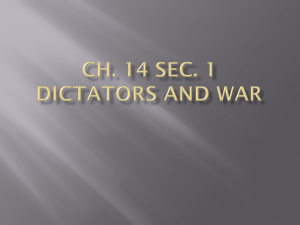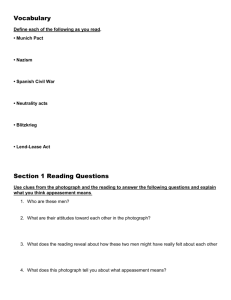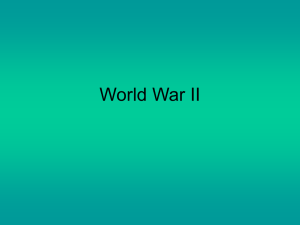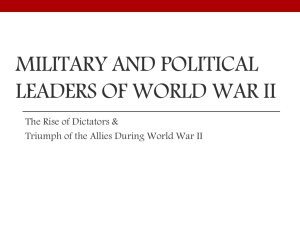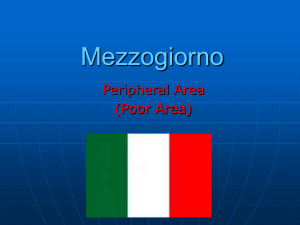Appeasement and the Road to War, to 1939 Assessment: In the
advertisement
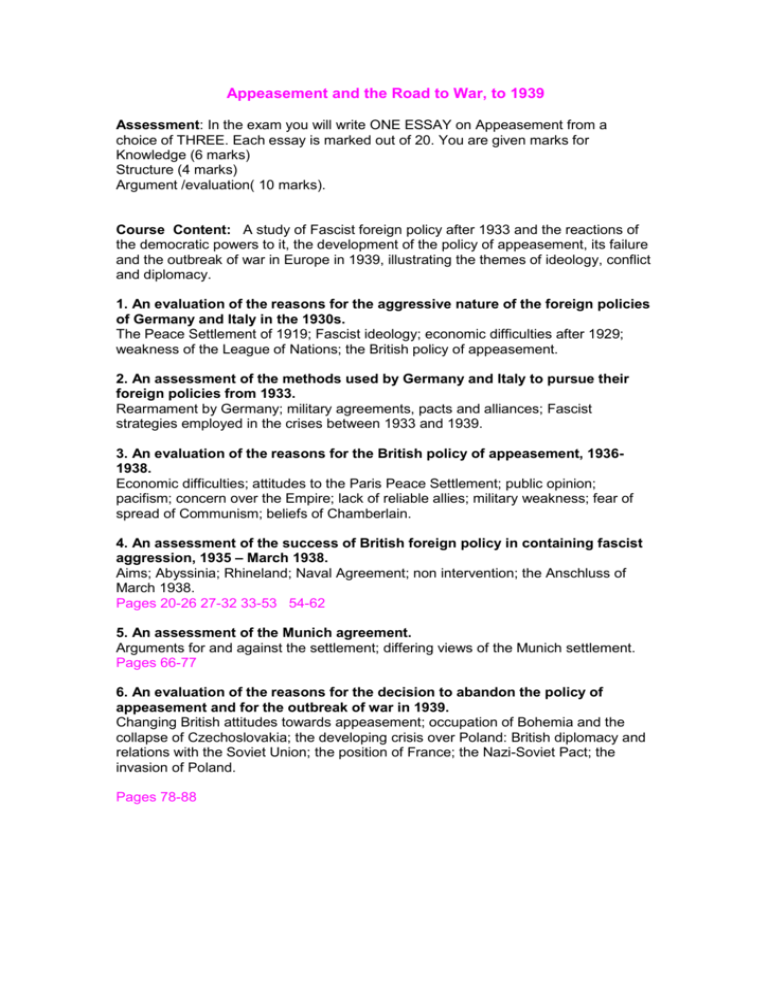
Appeasement and the Road to War, to 1939 Assessment: In the exam you will write ONE ESSAY on Appeasement from a choice of THREE. Each essay is marked out of 20. You are given marks for Knowledge (6 marks) Structure (4 marks) Argument /evaluation( 10 marks). Course Content: A study of Fascist foreign policy after 1933 and the reactions of the democratic powers to it, the development of the policy of appeasement, its failure and the outbreak of war in Europe in 1939, illustrating the themes of ideology, conflict and diplomacy. 1. An evaluation of the reasons for the aggressive nature of the foreign policies of Germany and Italy in the 1930s. The Peace Settlement of 1919; Fascist ideology; economic difficulties after 1929; weakness of the League of Nations; the British policy of appeasement. 2. An assessment of the methods used by Germany and Italy to pursue their foreign policies from 1933. Rearmament by Germany; military agreements, pacts and alliances; Fascist strategies employed in the crises between 1933 and 1939. 3. An evaluation of the reasons for the British policy of appeasement, 19361938. Economic difficulties; attitudes to the Paris Peace Settlement; public opinion; pacifism; concern over the Empire; lack of reliable allies; military weakness; fear of spread of Communism; beliefs of Chamberlain. 4. An assessment of the success of British foreign policy in containing fascist aggression, 1935 – March 1938. Aims; Abyssinia; Rhineland; Naval Agreement; non intervention; the Anschluss of March 1938. Pages 20-26 27-32 33-53 54-62 5. An assessment of the Munich agreement. Arguments for and against the settlement; differing views of the Munich settlement. Pages 66-77 6. An evaluation of the reasons for the decision to abandon the policy of appeasement and for the outbreak of war in 1939. Changing British attitudes towards appeasement; occupation of Bohemia and the collapse of Czechoslovakia; the developing crisis over Poland: British diplomacy and relations with the Soviet Union; the position of France; the Nazi-Soviet Pact; the invasion of Poland. Pages 78-88 Task one: Each topic we study will follow a similar pattern We will read and discuss the section with this your teacher. Take detailed notes individually on the key points from the chapter. As a class you will take turns to run a detailed tutorial and then provide a revision/ recall sheet to the rest of the class at the end of the tutorial. Each tutorial should be prepared with discussion points and a video clip if possible by the two students in charge. Product Criteria At least 4 knowledge points Structural tips: introduction, conclusion and overall structure Outline the main arguments and how you would put them together A video clip on your topic Who’s Who? Do you know anything about the following people? Clement Atlee Stanley Baldwin Neville Chamberlain Winston Churchill Anthony Eden Francisco Franco Adolf Hitler David Low Benito Mussolini Joseph Stalin Challenge 1 They are some of the key characters to be studied. Use page 1 of the textbook to make a brief note on each. The Peace Settlements of 1919 Germany The War Guilt Clausefull responsibility for starting WW1 Reparation payments of £6,600,000 Disarmament- no tanks, no military air force, no conscription, no u-boats, army of 100,000 men, Rhineland de-militarised, no defences on the French border Loss of overseas colonies No Anschluss Alsace and Lorraine returned to France Eupen and Malmedy returned to Belgium Posen, West Prussia and part of Upper Silesia to go to Poland. The Saar coalfield to be transferred to France for 15 years. Italy Italy switched sides in April 1915 so was not going to be punished like Germany and AH. Signor Orlando the Italian PM walked out of the Conference but came back to ensure Italy was not left empty handed. The Treaty of St Germain gave Italy the South Tyrol, Trentino, Istria and the use of the port of Trieste. However, she did not get a share of the German colonies. No share of reparation payments. Section One: The Peace Settlements of 1919 & Fascist Ideology Product Criteria You are going to produce a handout for the class answering the question To what extent did the Peace Settlement of 1919 and Fascist ideology cause Germany OR Italy to peruse an aggressive foreign policy? Form Criteria -You will split into TWO groups -One will research Italian reaction to the Peace Settlement and Italian Fascism under Mussolini. -The other will research German reaction to the Peace Settlement and Germany fascism. Resources Using the information above Appeasement textbook pages 13 & 14. Growth of Nationalism textbook pages 46-47 (Italy) 125-127 (Germany). The Impact of the Great Depression on Italy and Germany Group challenge One group will research Italy and the other Germany you must provide an information sheet for the class. Your teacher will give you a range of resources to help with your notes. Section Two: Weaknesses of the League of Nations 1. Read pages 6 to 10 and think about how it helps you to fill in the table below question: Use the info from pages 8-11 to exemplify the reactions. Germany Reaction to the League of Nations France Britain Italy USSR USA 2. Take notes on what impact the Manchurian crisis had on The League, Britain, France, Italy, USA and possibly Germany and Italy. 3. Section Three: German and Italian Foreign Policy 193335 1. Read pages 13-19 and make notes using the following headings to help you. German motives/aims The Failure of the Disarmament Conference German Rearmament and Arms Appeasement 2. Read pages 20-26 and make notes on the following Italy’s immediate motives in Abyssinia British and French reaction Role of the League/ Hoare Laval Pact British public reaction to the Hoare Laval Pact Implications of the incident on the future of European security. Group Presentation One. Rule Criteria Group of 3 people You must meet your deadline: One week, Prepare a revision sheet Form Criteria You must evaluate the reasons for the aggressive nature of the foreign policies of Germany and Italy in the 1930s. You must mention the following points and their individual significance: o The Peace Settlement of 1919; o Fascist ideology o Economic difficulties after 1929 o Weakness of the League of Nations o Abyssinian Crisis o The British policy of appeasement. You must have a KU section You must have an argument and evaluation section. You must have a historiography section. Video clip. Section Four : The Rhineland Crisis March 1936 1. Outline Hitler’s motives for re-militarising the Rhineland in 1936. 2. British gvt reaction 3. French gvt Reaction 4. The methods used by Germany to further peruse her foreign policy objectives 5. Evaluate the reasons why Britain followed a policy of nonIntervention and the success of this policy. (mention public opinion; pacifism; concern over the Empire; lack of reliable allies; military weakness; economic problems; fear of spread of Communism) THE RHINELAND – POINTS FOR DISCUSSION “Could Hitler Have been stopped at this stage?” Split the class into two groups Prepare at least three detailed ARGUMENTS which support OR reject this view. Use detailed KNOWLEDGE AND UNDERSTANDING evidence to support each of your arguments. YES Britain and France could have resisted the invasion French army was bigger and stronger then the German one Sanctions could have been imposed NO: France and Britain were not confident enough Politicians in Britain were pro-German Public lack of support for war Fear of communism greater than fascism Group Presentation Two. Rule Criteria Group of 3 people You must meet your deadline: One week, Prepare a revision sheet Form Criteria You must evaluate the reasons for the Rhineland Crisis and the reaction to it. You must mention the following points and their individual significance: o Outline Hitler’s motives for re-militarising the Rhineland in 1936; o Italian reaction o British reaction- popular opinion and political reaction o French reaction o The British policy of appeasement. You must have a KU section You must have an argument and evaluation section. You must have a historiography section. Video clip. Section Five: The Spanish Civil War 1936-39 p33- 53 1. Pages 33-40 it is just background so do not take notes. Your teacher will discuss it with you. 2. The methods used by Germany and Italy to further peruse their foreign policy objectives. 3. Evaluate the reasons why Britain followed a policy of nonintervention and the success of this policy. (mention public opinion; pacifism; concern over the Empire; lack of reliable allies; military weakness; economic problems; fear of spread of Communism) Group Presentation Three. Rule Criteria Group of 3 people You must meet your deadline: One week, Prepare a revision sheet Form Criteria You must evaluate the impact the Spanish Civil War has on European security You must mention the following points and their individual significance: o German and Italian intervention o British reaction- popular opinion and political reaction o French reaction o German and Italian reaction to NYON conference o The British policy of appeasement. You must have a KU section You must have an argument and evaluation section. You must have a historiography section. You must have a clip. Homework then timed Essay1: To what extent do economic difficulties explain the aggressive nature of fascist foreign policies up until 1936? Section Six: 1. 2. 3. An assessment of the British reasons for pursuing a policy of appeasement and the Anschluss. Read pages 54-58 and page 63 and review why Britain pursued a policy of Appeasement from 1930-1936. Read pages 58-62 and highlight Germany’s motives for the Anshluss and how it helped her and Italy peruse their fascist foreign policy Read pages 58-65 on the Anschluss to help you answer the question and address the reasons why Britain followed the policy of appeasement and how successful her policy was. Group Presentation Four. Rule Criteria Group of 3 people You must meet your deadline: One week, Prepare a revision sheet Form Criteria You must evaluate the reasons why Britain followed a policy of Appeasement. You must evaluate the success of the policy by using examples from all the crisis’s you have looked at so far. You must have a KU section You must have an argument and evaluation section. You must have a historiography section Video clip. Timed essay: How successful was Britain’s policy of Appeasement in containing fascist aggression between 1935-38? 20 marks. HIGHER HISTORY ESSAY MARKING RUBRIC: EYE OF THE TIGER CRITERIA STRUCTURE ARGUMENT K.U. (KNOWLEDGE & UNDERSTANDING HISTORIOGRAPHY D – Novice Historian C – Apprentice Historian Basic attempt at an introduction and conclusion. Possible lack of focus on question. Some organisation of the response. Minimal establishment of context. Connection made to question. Clear attempt at introduction, conclusion and development. Line of argument established. Conclusion linked to issue. Intro establishes the context and demonstrates a solid line of argument. Conclusion based on evidence presented and relates directly to issue. Focus is weak and little/ no argument made. There is some meaningful comment on issue but not discussed in depth. Overall style is narrative and descriptive in approach. Some evidence with meaningful comments that recognise the issue. There is a clear awareness of the issue to be addressed. Evidence is used to lead the development of the argument. The evidence is integrated into a developed and sustained analysis. Awareness of areas of debate. Narrative approach lack of specific detail and evidence. Knowledge and understanding of the issue is evident. Points are explained. Knowledge and understanding of the issue is extensive and points are well explained and developed. Use of historiography to support points made. Extensive historiography included to enhance debate. Awareness of differing interpretations. Points are narrative and lack detail. No attempt made to include historiography. Possible attempt at historiography but not developed. B – Practitioner Historian A – Master Historian A+ SUPERB! WOW! SUPERB! WOW! Section Seven: An assessment of the British reasons for pursuing a policy of appeasement and the Anschluss. Read pages 66-79 Take notes which assess the Munich agreement. Give arguments for and against the settlement; differing views of the Munich settlement. Czech Crisis Challenge Rule Criteria Working in random groups of 5 You must meet your deadline At least 3 of your group must appear in your trailer. Form Criteria You must pitch must explain your action film/ soap opera/ musical/ bbc period drama in every detail You must include a 2 minute “trailer” for your action film/ soap opera / musical/ bbc period drama/ romantic comedy. You must have a tagline for your production. You must have a poster to advertise your production You must have a name for your project, relevant soundtrack and a cast There must be a clear, relevant plot line explaining what factors lead up to the Czech Crisis, the negotiations to stop it, the consequences of it and what type of appeasement it was. Content Criteria You must refer to accurate information from the textbook. You must have a plot Your pitch must be no longer than 5 minutes long including your 2 minute trailer. Deadline week from now… Essay Topic One: .An evaluation of the reasons for the aggressive nature of the foreign policies of Germany and Italy in the 1930s. Relevant Points The Peace Settlement of 1919 Fascist ideology Economic difficulties after 1929 Weakness of the League of Nations The British policy of appeasement. Arguments Argument One: Evidence to show that The Peace Settlement of 1919 DID made Fascist foreign policy more aggressive. Evidence to show that The Peace Settlement of 1919 DID NOT make Fascist foreign policy more aggressive. Argument Two: Evidence to show that Fascist ideology DID made Fascist foreign policy more aggressive. Evidence to show that Fascist ideology DID NOT make Fascist foreign policy more aggressive Argument Three: Evidence to show that Economic difficulties after 1929 DID made Fascist foreign policy more aggressive. Evidence to show that Economic difficulties after 1929 DID NOT make Fascist foreign policy more aggressive. Argument Four: Evidence to show that Weakness of the League of Nations DID made Fascist foreign policy more aggressive. Evidence to show that Weakness of the League of Nations DID NOT make Fascist foreign policy more aggressive. Argument Five: Evidence to show that The British policy of appeasement DID made Fascist foreign policy more aggressive. Evidence to show that The British policy of appeasement DID NOT make Fascist foreign policy more aggressive. Essay Topic Two: . An assessment of the methods used by Germany and Italy to pursue their foreign policies from 1933. Essay question Two: “Bullying and bluff.” How accurate is this description of the methods used by the fascist powers to pursue their foreign policy aims in the years after 1933? Relevant Points Rearmament by Germany Military agreements, pacts and alliances Fascist strategies employed in the crises between 1933 and 1939. Arguments Argument One: Evidence to show that Rearmament by Germany was a method used by Germany and Italy to pursue their foreign policies from 1933. Evidence to show that Rearmament by Germany was not a method used by Germany and Italy to pursue their foreign policies from 1933. Argument Two: Evidence to show that Military agreements, pacts and alliances was a method used by Germany and Italy to pursue their foreign policies from 1933. Evidence to show that Military agreements, pacts and alliances was not a method used by Germany and Italy to pursue their foreign policies from 1933. Argument Three: a. Abyssinia b. Rhineland c. Spain d. Austria e. Czechoslovakia ( f Poland) Evidence to show that Fascist strategies employed in the crises between 1933 and 1939 was a method used by Germany and Italy to pursue their foreign policies from 1933. Evidence to show that Fascist strategies employed in the crises between 1933 and 1939was not a method used by Germany and Italy to pursue their foreign policies from 1933. Mark Scheme The candidate assesses the extent to which fascist foreign policy in the 1930s relied on the use of military force by comparison with political, diplomatic, economic and other methods, using evidence and arguments such as: Military force • The militaristic nature and image of Fascism/Nazism. Introduced conscription/ Luftwaffe: Airforce/ Navy/Army • The speed and scale of rearmament, including conscription. Ger very fast. Italian struggled due to poor economy • The emphasis on air power and the growing threat from the air. Italy’s naval ambitions in the Mediterranean – ‘Mare Nostrum’. Fascist strategies employed in the crises between 1933 and 1939 • Italian invasion of Abyssinia – provocation, methods, and relatively poor performance against very poorly equipped enemy. • German remilitarisation of Rhineland – Hitler’s gamble and timing, his generals’ opposition, lack of Allied resistance. • Spanish Civil War – aid to Nationalists, testing weapons and tactics, aerial bombing. • Anschluss – attempted coup 1934; relations with Schuschnigg; invasion itself relatively botched militarily; popularity of Anschluss in Austria. • Czechoslovakia – threats of 1938; invasion of March 1939. • Italian invasion of Albania – relatively easy annexation of a client state. • Poland – escalating demands; provocation, invasion. • The extent to which it was the threat of military force which was used rather than military force itself – e.g. Czechoslovakia in 1938; and the extent to which military force itself was effective and/or relied on an element of bluff – e.g. Rhineland. Military agreements, pacts and alliances • Diplomacy and the protestation of ‘peaceful’ intentions and ‘reasonable’ demands. • Appeals to sense of international equality and fairness and the righting of past wrongs e.g. Versailles. • Withdrawal from League and Disarmament Conference. • Signing of pacts, agreements and alliances: - German-Polish Non-Aggression Pact - Stresa Front – Italy, France, Britain - Anglo-German Naval Agreement - Austro-German agreement - Rome-Berlin Axis and Anti-Comintern Pact - Munich Agreement - Nazi-Soviet Non-Aggression Pact. • Clever timing and exploitation of weaknesses/divisions among potential opponents. • Use of economic influence and pressure, e.g. on south-eastern European states. Any other relevant factors. [ 3. An evaluation of the reasons for the British policy of appeasement, 1936-1938. Economic difficulties; attitudes to the Paris Peace Settlement; public opinion; pacifism; concern over the Empire; lack of reliable allies; military weakness; fear of spread of Communism; beliefs of Chamberlain. Essay Question 3:To what extent was Britain's adoption of a policy of appeasement between 1936 and 1938 the result of the beliefs of Chamberlain? The candidate evaluates the relative importance of the beliefs of Chamberlain in accounting for Britain's policy of appeasement between 1936 and 1938 by comparison with other relevant factors, using evidence and arguments such as: Beliefs of Chamberlain Avoid war at all costs Anti-communist stance- suspicion of Soviet Russia; Nazi Germany seen as a buffer and destabilising the Nazi regime might lead to questions over communist revolution in Germany. Diplomacy was stronger than threat- Outline evidence of diplomacy Trusts Hitler (do not mention Muinch) Military weakness • Run-down state of armed forces following WW1. • Army: conscription ended post WW1, scaled right down in size. • Navy: not so run-down but not fully maintained and many obsolete ships. • Air Force: lack of adequate air defences and fear of aerial bombing. • Multiple threats – Japan in the East, Italy in the Mediterranean and North Africa, Germany in Central Europe. • Warnings of Chiefs-of-Staff. • Exaggerated assessments of German military strength. 1919 Peace Settlement Too harsh on Germany and there was sympathy for what were seen by many as genuine grievances. Reluctance to enforce Treaty provisions and preference for policy of making concessions. Pacifism & Public Opinion Fear of another World War – recent memories of losses/horrors of WW1. Public anti-war feeling – Peace Ballot, Oxford 'King and Country' debate. • Economic difficulties Impact of 1929–32 economic depression, fear of damaging international trade. • Lack of reliable allies Failure of League of Nations, eg reaction to any crisis between 19361938. French political divisions, military weakness and Maginot mentality US isolationism weakness of eastern European successor states doubts over commitment of Empire and the Commonwealth in event of war. • • • Any other relevant factors.

